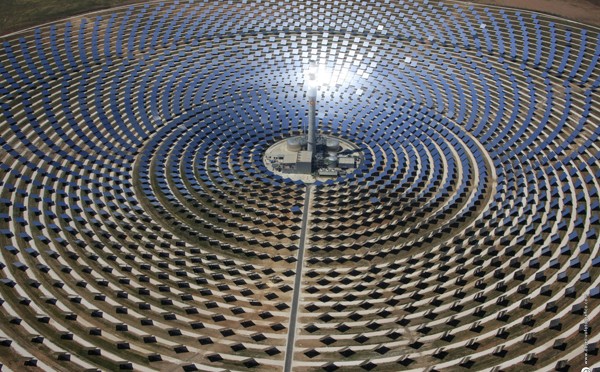The Concentrating Solar Power Alliance (CSPA), an advocacy organization dedicated to educating U.S. regulators, utilities and grid operators about the unique benefits of Concentrating Solar Power (CSP), today issued an updated version of a technical report titled, The Economic and Reliability Benefits of CSP with Thermal Energy Storage: Literature Review and Research Needs, 2014. First published in 2012, this revised and expanded 124 page report incorporates the latest research on the economic and reliability benefits of CSP with thermal energy storage and serves as a comprehensive guide to understanding the design and operational attributes of CSP plants with thermal energy storage.
“As the penetration of variable renewable energy resources increases worldwide, more attention is being paid to the effects of renewable energy on power system reliability and operations,” said Tex Wilkins, executive director of the CSP Alliance. “As we explore in this report, CSP with thermal energy storage is a potential solution that meets clean energy and climate change policy goals, reduces the variability of the aggregate renewable energy portfolios and provides a wide range of operational and reliability benefits.”
The full range of utility and market services in energy, ancillary services and capacity are reviewed in detail, including valuation methodologies. Resource adequacy, long term reliability, integration and curtailment costs are examined together with estimates of total power system economic benefits for CSP with thermal storage. Implications for U.S. and international regulatory and market regimes are also explored, together with recommendations for future research.
“This report is intended for utilities, regulators, policymakers and grid operators, and it presents a framework for more informed decision-making in the evaluation of competing resources to achieve better outcomes for energy consumers,” said Joe Desmond, senior vice president of marketing and government affairs for BrightSource Energy, a CSPA member company. “As evidenced in this report, CSP is uniquely positioned to be a cornerstone of a low carbon energy mix with its long-term economic and reliability value.”
Among the report’s key highlights:
- CSP with thermal energy storage is shown to be much more competitive when the comprehensive net grid system costs of the CSP plant are compared to wind or solar photovoltaics (PV). These net costs include the long-term energy, ancillary service and capacity benefits and have been shown to provide an additional $30-60/MWh, or even higher, of benefits when compared to a PV plant with equal annual energy production in high renewable penetration scenarios. This finding is critical for the development of renewable energy portfolios in regions with high solar potential.
- As renewable energy penetration increases, the operational flexibility offered by CSP with storage supports integration of wind and PV. While some studies have pointed to the possibility of curtailment of renewable energy generation, this could be reduced by maintaining dispatchable resources in the portfolio.
- New to this report are comprehensive summaries of policies, regulatory and market structures for regions with high potential for CSP development around the world, including the Americas (U.S., Mexico, Brazil and Chile), Southern Europe, North Africa, Middle East, Southern Africa, China, India and Australia.
As regulators, utilities and grid operators consider future energy portfolios and procurement decisions, they are increasingly applying a “net system cost” methodology when evaluating resources, which considers factors such as system integration and reliability under different scenarios. The findings presented in this report will contribute to the evolution of those methodologies and a more appropriate valuation of a dispatchable, clean energy resource such as CSP with thermal energy storage.
To download the full report, including a comprehensive list of literature, studies and research used in the report, please visit http://www.brightsourceenergy.com/new-report#.VBCBG0t9RB9.
The CSP Alliance is a public policy advocacy organization dedicated to bringing increased awareness and visibility to this sustainable, dispatchable technology. Our membership includes many of the world’s largest CSP corporations and their supply-chain partners. Our objectives include advancing the industry’s value proposition, addressing issues of job creation and environmental sustainability, and setting the foundation for future uses of the technology. Click here to see our current members.
For more information about CSP Alliance, visit http://www.csp-alliance.org.
• As renewable energy penetration increases, the operational flexibility offered by CSP with storage supports integration of wind and PV. While some studies have pointed to the possibility of curtailment of renewable energy generation, this could be reduced by maintaining dispatchable resources within the resource portfolio.
• New to this report are comprehensive summaries of policies, regulatory and market structures for regions with high potential for CSP development around the world, including the Americas (U.S., Mexico, Brazil and Chile), Southern Europe, North Africa, Middle East, Southern Africa, China, India and Australia.
2. Design and Operational Attributes of CSP with Thermal Energy Storage
3. Utility or Market Services Offered by CSP with Thermal Energy Storage
4. Valuation of Renewable Resources – Definition of Net System Cost and Quantitative Methods
5. Valuation of Renewable Resources – Implication of Regulatory and Market Regimes
6. Looking to the Future: Simulating Power Systems under High Renewable Scenarios
7. Energy and Ancillary Services
8. Resource Adequacy and Long-term Reliability
9. Integration and Curtailment Costs
10. The Total Economic Benefits of CSP with Thermal Storage
11. Incorporating Market and Reliability Valuation into CSP Plant Design
12. Conclusions and Next Steps
Appendix A: Methodologies for Calculating Capacity Value of CSP with Thermal Energy Storage
Appendix B: Simplified Calculation of Integration Costs in California under 33% RPS



